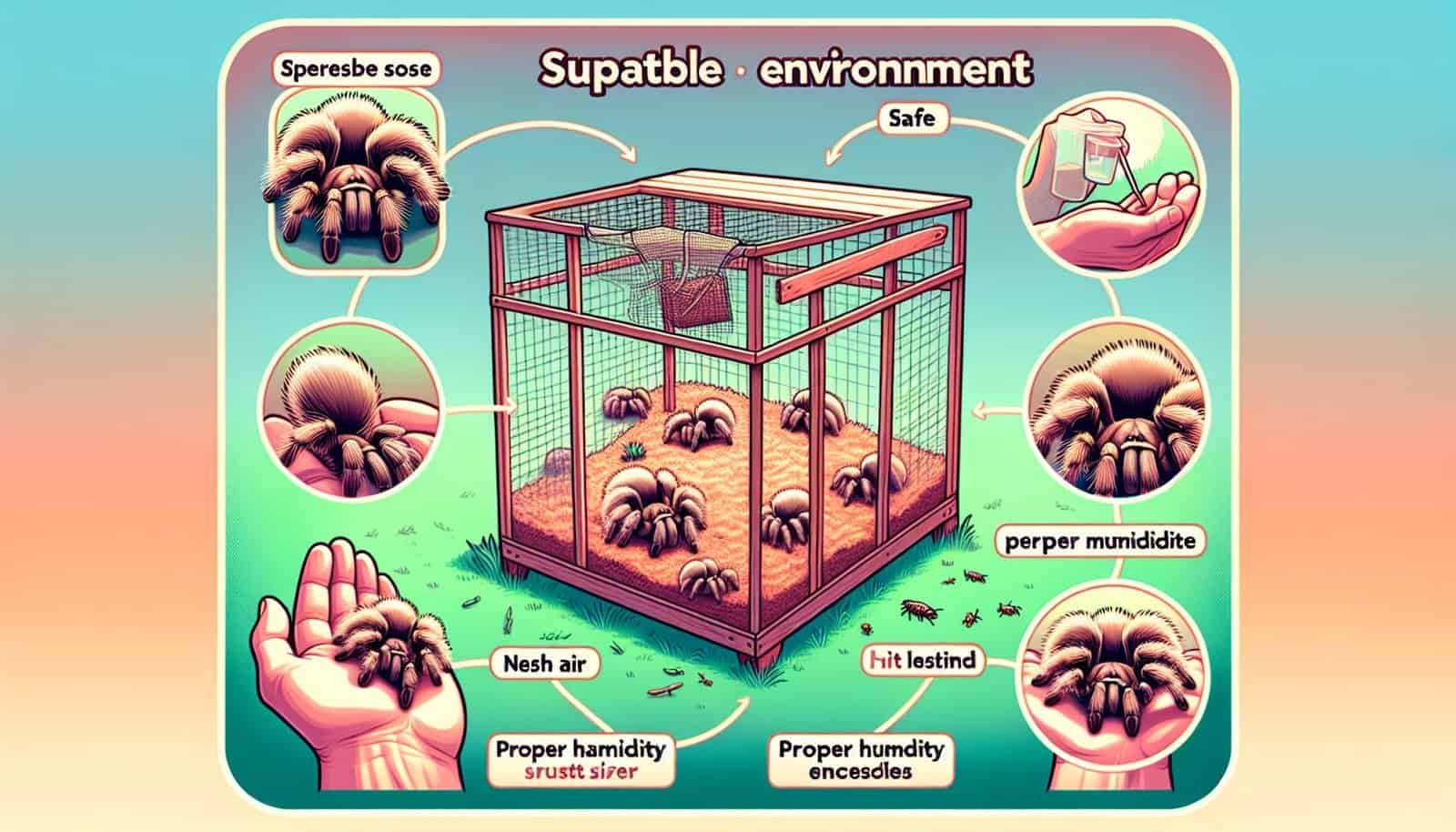So you’ve just brought home your adorable tarantula spiderling, but now you’re wondering what size enclosure is best for it. Well, fear not! In this article, we’ll explore the ideal size enclosure to provide a comfortable and secure habitat for your little eight-legged friend. From discussing the importance of space to considering the growth rate of tarantula spiderlings, we’ve got you covered. By the end, you’ll have all the knowledge you need to create the perfect home for your tiny arachnid companion.

Choosing the Right Size Enclosure
When it comes to housing your tarantula spiderlings, choosing the right size enclosure is crucial. The size of the enclosure plays a significant role in the spiderlings’ overall well-being and development. It provides them with a comfortable and secure environment where they can thrive. However, finding the perfect enclosure size can be a daunting task, with various factors to consider. In this article, we will delve into the factors to consider when choosing the right size enclosure, the ideal enclosure sizes for tarantula spiderlings, enclosure types, ventilation, creating a suitable environment, avoiding common enclosure mistakes, addressing specific tarantula species, transitioning between enclosures, monitoring and maintenance, and conclude with a summarized overview.
Factors to Consider
Several factors come into play when determining the appropriate enclosure size for your tarantula spiderlings. Firstly, you need to consider the size and growth rate of your spiderlings. Spiderlings undergo molts and gradually grow in size, so it’s essential to anticipate their future growth when selecting an enclosure size. Additionally, you must take into account the natural habitat and behaviors of these spiderlings. Different tarantula species have varying environmental needs and behaviors, which should be considered when determining the enclosure size. Lastly, the availability of space in your home or living area also plays a role, as you need to ensure that the enclosure fits comfortably within its intended location.
Importance of Proper Enclosure Size
Providing your tarantula spiderlings with an appropriately sized enclosure is vital for their well-being. If the enclosure is too large, spiderlings may struggle to find their food, leading to stress and potential malnourishment. On the other hand, if the enclosure is too small, spiderlings may feel cramped and restricted, hindering their natural movements and potentially causing stress. Maintaining the right enclosure size ensures that spiderlings can exhibit their natural behaviors, including burrowing, climbing, and hunting, providing them with physical and mental stimulation necessary for their overall health.
Ideal Enclosure Sizes for Tarantula Spiderlings
Determining the specific size requirements for your tarantula spiderlings depends on their stage of development. Spiderlings generally go through several stages before reaching maturity, with their enclosure needs changing as they grow. Understanding these stages and the corresponding recommended sizes for each can greatly contribute to the well-being of your spiderlings.
Determining Spiderling Size
To determine the appropriate enclosure size for your spiderlings, you need to measure their leg span. The leg span refers to the distance between the extended tips of the front and back legs, excluding the first pair of legs. By measuring the leg span, you can estimate the spiderling’s current stage of development and select the suitable enclosure size accordingly.
Recommended Sizes for Different Spiderling Stages
For spiderlings with a leg span of less than 1 inch (2.5 cm), a small vial or deli cup can serve as a suitable enclosure. These small containers provide enough space for the spiderlings to move around comfortably while ensuring easy access to food and water.
As the spiderlings grow and reach a leg span of 1 to 2 inches (2.5 to 5 cm), a small plastic container or a pill bottle can be used as an enclosure. These containers offer a bit more space for the spiderlings to explore and burrow, accommodating their growing size.
Once the spiderlings reach a leg span of 2 to 3 inches (5 to 7.6 cm), it is time to upgrade to a larger enclosure. A plastic critter keeper or a small terrarium can be suitable options at this stage, providing ample room for the spiderlings to maneuver and exhibit natural behaviors.
Benefits of Using Aptly Sized Enclosures
Using aptly sized enclosures for your tarantula spiderlings provides numerous benefits. Firstly, it ensures that the spiderlings can access their food easily, reducing the risk of malnourishment or starvation. Secondly, appropriate enclosure sizes allow spiderlings to move freely and engage in natural behaviors such as burrowing and climbing. This promotes physical and mental stimulation, contributing to their overall health and well-being. Lastly, using the right-sized enclosures simplifies maintenance tasks such as cleaning and monitoring, making it easier for you to provide a suitable environment for your spiderlings.
Enclosure Types for Spiderlings
Tarantula spiderlings can be categorized into two general groups based on their natural habitats and behavior – terrestrial and arboreal. Understanding these categories is essential when selecting the appropriate enclosure type for your spiderlings.
Terrestrial Enclosures
Terrestrial tarantula spiderlings are typically ground-dwelling species that prefer to burrow rather than climb. They require an enclosure that provides enough floor space for them to dig and burrow comfortably. A low, flat enclosure is ideal for terrestrial species, allowing them to exhibit their natural behaviors without the risk of falling from heights.
Arboreal Enclosures
Arboreal tarantula spiderlings, on the other hand, are tree-dwelling species that prefer to climb and build intricate web structures. For these species, vertical height is crucial. Enclosures with ample height and climbing structures such as branches or cork bark are recommended, providing them with opportunities for climbing and web creation.
Enclosure Materials and Design Considerations
When selecting enclosure materials, it is important to prioritize the safety and well-being of your spiderlings. Glass enclosures are a popular choice due to their visibility, ease of cleaning, and suitability for maintaining humidity levels. Plastic containers can also be used for temporary enclosures, as long as they offer adequate ventilation and security. It is crucial to ensure that the enclosure design provides adequate security to prevent any escapes or injuries. Screened tops or secure lids are essential features to consider for preventing any mishaps.
Providing Adequate Ventilation
Proper ventilation is a crucial aspect of tarantula spiderling enclosures. It ensures the exchange of fresh air while preventing the buildup of excessive humidity or stagnant air. Adequate ventilation is vital for maintaining the health and well-being of your spiderlings.
The Importance of Ventilation
Good ventilation allows for proper airflow, reducing the risk of respiratory problems and mold growth. It helps to maintain optimal humidity levels and prevents the accumulation of waste gases. Adequate ventilation also contributes to the overall air quality within the enclosure, ensuring a healthy environment for your spiderlings to thrive.
Ventilation Solutions for Enclosures
There are various ventilation solutions you can implement to ensure proper airflow within tarantula spiderling enclosures. Ventilation can be achieved through screened areas on the enclosure’s sides or top, allowing air to circulate while preventing escapes. Another option is the use of small ventilation holes strategically placed throughout the enclosure, promoting airflow without compromising the security of your spiderlings. Additionally, placing enclosures in well-ventilated areas of your home can also contribute to optimal ventilation.
Avoiding Excessive Airflow
While ventilation is crucial, it is equally important to avoid excessive airflow within the enclosure. Tarantula spiderlings are sensitive creatures, and excessive airflow can cause stress and potentially lead to health issues. Therefore, it is vital to strike a balance between providing sufficient airflow and avoiding drafts or strong airflow that could disturb your spiderlings.

Creating a Suitable Environment
Apart from the size and type of enclosure, creating a suitable environment within the enclosure is vital for the well-being of your tarantula spiderlings. The environment should mimic their natural habitat as closely as possible, ensuring their physical and mental stimulation.
Substrate Choices
Choosing the right substrate is essential for creating a suitable environment for your tarantula spiderlings. Substrate materials such as coconut fiber or peat moss can offer the necessary moisture retention and burrowing opportunities. Avoid substrate options such as sand or wood chips, as they can cause irritations or injury to your spiderlings.
Furnishing the Enclosure
To promote natural behaviors, you can consider adding various furnishings to the enclosure. For terrestrial species, providing hides such as cork bark or half flower pots can give them a secure and comfortable place to rest or hide. For arboreal species, vertical climbing structures such as branches or vertically oriented cork bark can provide opportunities for climbing and web building.
Lighting and Heat Requirements
Tarantulas are nocturnal creatures and do not require specific lighting sources. However, providing a natural day-night cycle through ambient room lighting can help to regulate their biological rhythms. In terms of heat, tarantulas are generally tolerant of a wide range of temperatures. It is essential to ensure that the enclosure remains within an appropriate temperature range for the species you are housing. Regular monitoring of temperature levels is recommended to prevent any extremes that could negatively impact the spiderlings.
Maintaining Humidity Levels
Maintaining the appropriate humidity levels within the enclosure is vital for the overall health of tarantula spiderlings. Different tarantula species have varying humidity requirements, and it is crucial to research and understand their specific needs. Techniques such as misting the enclosure with water or using a humidity gauge can help you monitor and maintain the desired humidity levels.
Avoiding Common Enclosure Mistakes
While providing the right enclosure for your tarantula spiderlings is important, it is equally crucial to avoid common mistakes that can have negative consequences for their well-being. By avoiding these mistakes, you can ensure a safe and comfortable living environment for your spiderlings.
Not Considering Future Growth
One common mistake is failing to consider the future growth of your tarantula spiderlings when selecting an enclosure size. It is important to anticipate their growth and choose an enclosure that allows for their expanding size. Upgrading enclosures as they grow ensures that they have enough space to move and thrive.
Using Enclosures That Are Too Big
While providing ample space for your tarantula spiderlings is important, using enclosures that are excessively large can cause stress and make it difficult for them to locate their food sources. It is crucial to strike a balance between providing enough space for natural behaviors and ensuring that food and water are easily accessible.
Inadequate Security Measures
Another common mistake is neglecting to include adequate security measures in the enclosure design. Tarantula enclosures should have secure lids or screened tops to prevent escapes or injuries. Failing to provide these security measures can lead to potential harm to your spiderlings or inconvenience and stress for both you and your spiderlings.
Ignoring Individual Species Requirements
Different tarantula species have specific environmental needs that need to be considered when setting up their enclosures. Ignoring these species-specific requirements can negatively impact the well-being and health of your spiderlings. It is important to research and understand the specific needs of the species you are housing and provide the appropriate enclosure conditions accordingly.

Addressing Specific Tarantula Species
Understanding the specific needs and behaviors of different tarantula species is crucial for providing the optimal enclosure size and conditions. Here, we provide examples of recommended enclosure sizes for some common tarantula species.
Examples of Recommended Enclosure Sizes
For spiderlings of the Avicularia genus, such as the Pink Toe Tarantula (Avicularia avicularia), an arboreal enclosure with a height of around 4 to 6 inches (10 to 15 cm) is suitable. For the Brachypelma genus, including the Mexican Red Knee (Brachypelma hamorii), a terrestrial enclosure with a length, width, and height of at least 10 inches (25 cm) is recommended.
Species-Specific Needs and Behaviors
Each tarantula species has specific needs and behaviors that should be taken into account when determining their enclosure size and conditions. Some species may require more humidity, while others may prefer drier environments. Researching and understanding these species-specific requirements will enable you to provide a suitable and comfortable living environment for your tarantula spiderlings.
Transitioning Between Enclosures
As your tarantula spiderlings grow, they will outgrow their current enclosures, necessitating the transition to a larger space. Understanding the growth milestones and proper practices for transitioning between enclosures is crucial for ensuring a smooth and safe process.
Growth Milestones and Upgrading Enclosures
Tarantula spiderlings typically go through multiple molts before reaching maturity. Each molt signifies growth, and their physical needs may change accordingly. Monitoring their leg span and recognizing when they have outgrown their current enclosure is essential. When upgrading enclosures, ensure that the new enclosure provides adequate space and appropriate environmental conditions for their current stage of development.
Safe Handling and Rehousing Practices
Transitioning between enclosures requires proper handling and rehousing practices to minimize stress and avoid potential harm to your spiderlings. When handling tarantula spiderlings, it is important to exercise caution and use gentle techniques to prevent injuries. Utilize appropriate tools such as catch cups or paintbrushes to safely move your spiderlings into their new enclosure. Avoid unnecessary handling whenever possible, as it can cause stress and potential harm.

Monitoring and Maintenance
Regular monitoring and maintenance of tarantula spiderling enclosures are essential for ensuring their well-being and addressing any potential issues promptly. By paying close attention to their growth, cleanliness, and overall environment, you can provide the best care for your spiderlings.
Monitoring Spiderlings’ Growth
Regularly measuring the leg span of your spiderlings allows you to track their growth and anticipate their future enclosure needs. This information enables you to plan for necessary upgrades and avoid keeping them in enclosures that are too small or too large.
Routine Cleaning and Maintenance
Maintaining a clean environment is crucial for the health and well-being of your tarantula spiderlings. Regularly remove any uneaten food, sheddings, or waste from the enclosure. Clean the enclosure and furnishings using safe cleaning solutions and ensure that the substrate is kept fresh and dry. Routine maintenance helps prevent the buildup of bacteria or mold that could negatively impact your spiderlings’ health.
Signs of Inadequate Enclosure Size
Observing your tarantula spiderlings’ behavior and overall well-being can indicate whether or not their enclosure size is appropriate. Signs of inadequate enclosure size include excessive pacing, webbing against enclosure walls, refusing food, or exhibiting stress-related behaviors such as hair-kicking or excessive grooming. If you notice any of these signs, it may be an indication that it is time to assess and potentially upgrade their enclosure size.
Conclusion
Choosing the right size enclosure for your tarantula spiderlings is vital for their health, well-being, and development. Considering factors such as size and growth rate, species-specific needs, and appropriate environmental conditions will guide you in providing the optimal living environment for your spiderlings. By understanding their natural behaviors, fulfilling their enclosure requirements, and monitoring their growth and environment, you can ensure that your tarantula spiderlings thrive in a comfortable and secure habitat. Remember, always prioritize the safety and well-being of your spiderlings and seek expert advice if needed. With proper care and attention, your tarantula spiderlings will grow into magnificent creatures, bringing you joy and wonder as they navigate their journey towards maturity.

